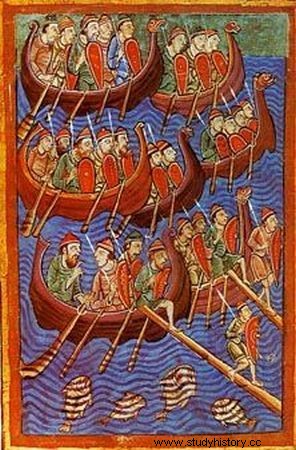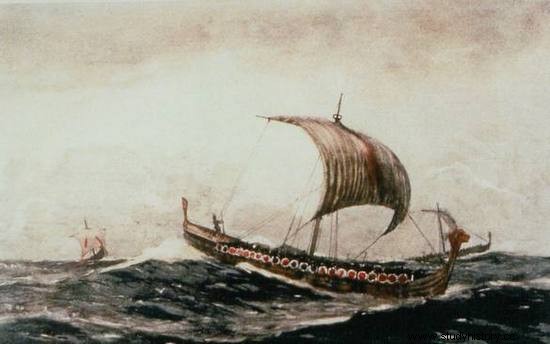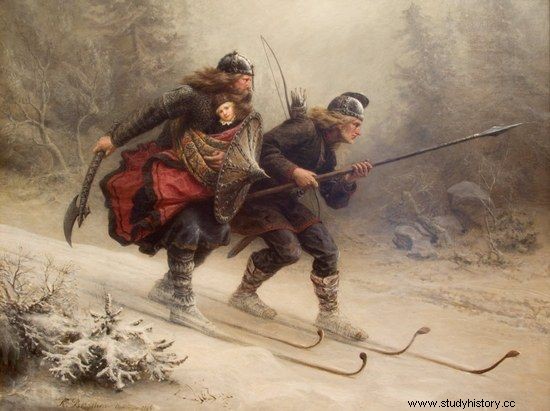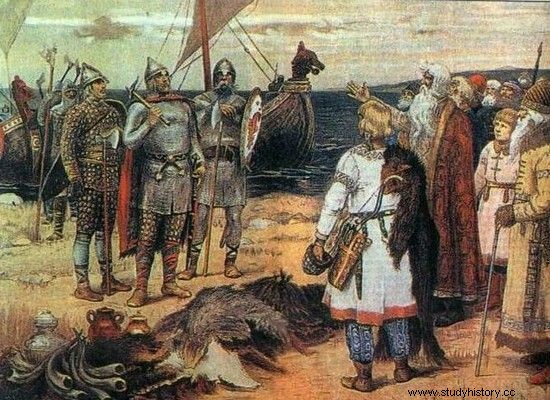The Vikings - the terror of medieval Western Europe - were famous mainly for their plunder, murder and rapes. But what did these dangerous plunderers do between successive military expeditions? Of course, they took care of their physical fitness by practicing various sports.
In mass culture, the image of the Viking has become established as a solid, strong as a turn, bearded man in a helmet with horns, who sowed terror wherever he appeared. While horned helmets that are worn on a daily basis should be put between fairy tales, the warriors of the cold north did care to be in good shape. And no wonder, as their lives often depended on it.
Fencing, archery and horse riding
The most important physical activity was exercising in the use of all kinds of weapons. Fighting with swords and axes was polished, but also javelin throwing and archery. Yes, archery is not a mistake! The Vikings were excellent archers, although nowadays they are mainly associated with great axes. As explained in his latest book "History of sport" prof. Wojciech Lipoński:

The Vikings were not only excellent sailors, they also did great with bows.
In the Old Irish poem Eddai in the sagas about Norwegian kings by Snorri Sturluson, Heimskringla (Circle of the world), the art of archery is mentioned several times as one of the most important skills of a warrior . Einar Tambarskjaelve, one of the Old Norse chieftains, was able to shoot a dull arrow with a thick bow with a bow.
The warrior also had to ride horses perfectly. Although the Vikings fought mainly on foot, they used horses to transport their loot and quickly reach the place where the boat was waiting for them. Horses were also used for specific entertainment known as hestathing ( hestaþing ). It consisted of rushing specially trained animals at each other, fighting with their hooves and even biting each other.
Swimming, Rowing and Skiing
The Vikings, however, were above all excellent sailors. After all, they were the first Europeans to reach the shores of North America. However, even for a great seaman, sailing the seas and oceans always carried enormous risks. A storm or strong wind could sink a ship or blow a careless daredevil off the deck. Therefore, the Vikings attached great importance to the improvement of swimming skills.
As Kirsten Wolf writes in the book "Daily Life of the Vikings", women also learned to swim, although their exercises did not take into account the element of competition that existed in the case of men. These competed mainly in long-distance swimming, diving and in what could be called waterboarding where two warriors tried to drag each other under the water.

During a storm it is easy to fall overboard, which is why the Vikings paid so much attention to polishing their swimming skills
The reminiscence of this sporting spirit can be found, for example, in the quoted by prof. Lipoński, the sons of Magnus the Good. There is a passage where Sigurd - King Eystein's brother - boasted: Remember that when we were swimming together, I could drag you into the water whenever I felt like it? The monarch, on the other hand, reminded his brother that he had swam the same distance as himself and that he dived just as deep.
Another - very original - Viking sport is connected with the sea. It is about paddle jumping used to propel ships. The competition took place, incidentally, while the crew was rowing with all their might. King Olaf Tryggvason was to be the master in this type of acrobatic performance. He was also mountaineering that was grown by many Vikings.
This article has more than one page. Please select another one below to continue reading.Attention! You are not on the first page of the article. If you want to read from the beginning click here.
Every inhabitant of the snowy north also had to skiing perfectly . Of course, skis were then mainly used as a means of moving over long distances, although their influence on improving physical fitness was appreciated.

Skiing for a Viking was very important, sometimes it could even save a life. King Haakon IV was a perfect example. Above, a picture of Knut Larson Bergslien
This is evidenced by the dialogue of the already quoted Sigurd and Eystein, where the latter rebukes his brother, saying: I was skiing so that no one managed to outdo me, and you could not do it better than an ox. We can see how important skiing skills were in the "History of sport". Professor Lipoński writes:
There were times when skis changed the history of the Vikings and their Scandinavian descendants. In 1869, the outstanding Norwegian painter, Knut Larson Bergslien, immortalized in one of his masterpieces the historic moment when two warriors, Torstein Skeivla and Skjervald Skrukka, saved the heir to the Norwegian throne, then Prince Haakon, who was two years old, from the heirs of a rival dynasty. Haakonsson, who later reigned as Haakon IV.
Wrestling and skin dragging

The article is based mainly on the book by Wojciech Lipoński entitled "History of sport" (Polish Scientific Publishers PWN, 2012).
Another sport that practiced physical fitness and was useful during plundering expeditions was wrestling . They became so popular that the Vikings distinguished between several varieties. The oldest and simplest of them was called buxnatök.
In turn, hryggspenna served to settle neighborly disputes . The other stock types were referred to as fang . This word - according to prof. Lipoński - in Old Irish meant a fight between two opponents.
Such a fight could take place for life or just for fun. In the first case it was illskufang where the combatants sought to inflict pain on themselves, mutilate their opponent and even kill them.
However, the leikfang was practiced much more often. In this case, the wrestlers tried to knock over the opponent, using protruding elements of their clothing. With time, they tried to diversify the fight by adding more leather belts to the outfit. This is how glíma was born - the national sport of Icelanders .

The Vikings were very concerned about physical fitness. It is no wonder, after all, it was her who depended their lives during numerous trade and looting expeditions.
Another extremely popular game - this time bloodless - was skin dragging - skinndráttur . The rules were very simple: two opponents, sitting opposite each other on the ground, tore a large animal skin from their hands and, pushing their feet, tried to drag the opponent to their side .
What more can I say? The Vikings hated idleness. Sport accompanied them every day and from holidays. No wonder that with such a dose of movement they were the terror of the continent ...
Sources:
Basic:
- Wojciech Lipoński, History of sport , Polish Scientific Publishers PWN, 2012.
Complementary:
- Kirsten Wolf, Daily Life of the Vikings , Greenwood Press, 2004.
